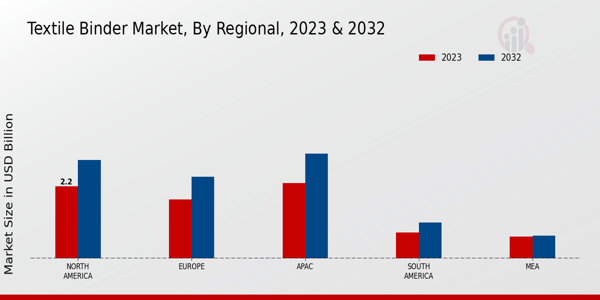Expansion of the Apparel Industry
The Global Textile Binder Market Industry is closely linked to the expansion of the apparel sector, which continues to thrive globally. As fashion trends evolve and consumer preferences shift towards personalized and diverse clothing options, the demand for textile binders is likely to increase. The apparel industry is projected to contribute significantly to the market's growth, with estimates suggesting a rise to 12.0 USD Billion by 2035. This expansion is fueled by the increasing production of garments, which necessitates the use of effective binders to ensure fabric integrity and performance. Consequently, the synergy between these industries is expected to drive market dynamics.
Growth in Home Textile Applications
The Global Textile Binder Market Industry is witnessing growth due to the rising demand for home textiles, including upholstery, curtains, and bedding. As consumers prioritize aesthetics and functionality in their living spaces, manufacturers are increasingly utilizing textile binders to enhance the performance and durability of these products. The home textile segment is anticipated to play a crucial role in market expansion, as it aligns with trends in interior design and home improvement. This sector's growth is likely to contribute to the overall market valuation, reinforcing the importance of textile binders in creating high-quality home textile products.
Rising Demand for Sustainable Textiles
The Global Textile Binder Market Industry is experiencing a notable shift towards sustainability, driven by increasing consumer awareness and regulatory pressures. As brands strive to reduce their environmental footprint, the demand for eco-friendly textile binders is on the rise. This trend is evident as manufacturers are developing binders derived from renewable resources, which aligns with the global push for sustainable practices. The market is projected to reach 8.32 USD Billion in 2024, reflecting a growing preference for sustainable materials in textile production. This shift not only caters to consumer preferences but also positions companies favorably in a competitive market.
Increased Investment in Research and Development
Investment in research and development is a pivotal driver for the Global Textile Binder Market Industry. Companies are allocating resources to innovate and improve binder formulations, focusing on enhancing performance, sustainability, and cost-effectiveness. This emphasis on R&D is crucial for maintaining competitive advantage in a rapidly evolving market. As a result, the industry is likely to see the emergence of new products that cater to specific consumer needs and preferences. The ongoing commitment to innovation is expected to bolster market growth, ensuring that textile binders remain integral to the production of high-quality textiles.
Technological Advancements in Binder Formulations
Innovations in binder formulations are significantly influencing the Global Textile Binder Market Industry. The introduction of advanced polymer technologies has led to the development of binders that offer enhanced performance characteristics, such as improved adhesion, flexibility, and durability. These advancements allow manufacturers to create textiles that meet the evolving demands of various applications, including apparel, home textiles, and industrial fabrics. As a result, the market is expected to grow steadily, with a projected CAGR of 3.41% from 2025 to 2035. This growth is indicative of the industry's commitment to integrating cutting-edge technologies into textile production processes.






















Leave a Comment